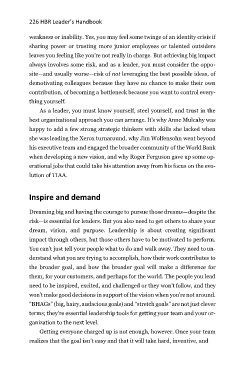Page 237 - HBR Leader's Handbook: Make an Impact, Inspire Your Organization, and Get to the Next Level
P. 237
226 HBR Leader’s Handbook
weakness or inability. Yes, you may feel some twinge of an identity crisis if
sharing power or trusting more junior employees or talented outsiders
leaves you feeling like you’re not really in charge. But achieving big impact
always involves some risk, and as a leader, you must consider the oppo-
site—and usually worse—risk of not leveraging the best possible ideas, of
demotivating colleagues because they have no chance to make their own
contribution, of becoming a bottleneck because you want to control every-
thing yourself.
As a leader, you must know yourself, steel yourself, and trust in the
best organizational approach you can arrange. It’s why Anne Mulcahy was
happy to add a few strong strategic thinkers with skills she lacked when
she was leading the Xerox turnaround, why Jim Wolfensohn went beyond
his executive team and engaged the broader community of the World Bank
when developing a new vision, and why Roger Ferguson gave up some op-
erational jobs that could take his attention away from his focus on the evo-
lution of TIAA.
Inspire and demand
Dreaming big and having the courage to pursue those dreams—despite the
risk—is essential for leaders. But you also need to get others to share your
dream, vision, and purpose. Leadership is about creating significant
impact through others, but those others have to be motivated to perform.
You can’t just tell your people what to do and walk away. They need to un-
derstand what you are trying to accomplish, how their work contributes to
the broader goal, and how the broader goal will make a difference for
them, for your customers, and perhaps for the world. The people you lead
need to be inspired, excited, and challenged or they won’t follow, and they
won’t make good decisions in support of the vision when you’re not around.
“BHAGs” (big, hairy, audacious goals) and “stretch goals” are not just clever
terms; they’re essential leadership tools for getting your team and your or-
ganization to the next level.
Getting everyone charged up is not enough, however. Once your team
realizes that the goal isn’t easy and that it will take hard, inventive, and

